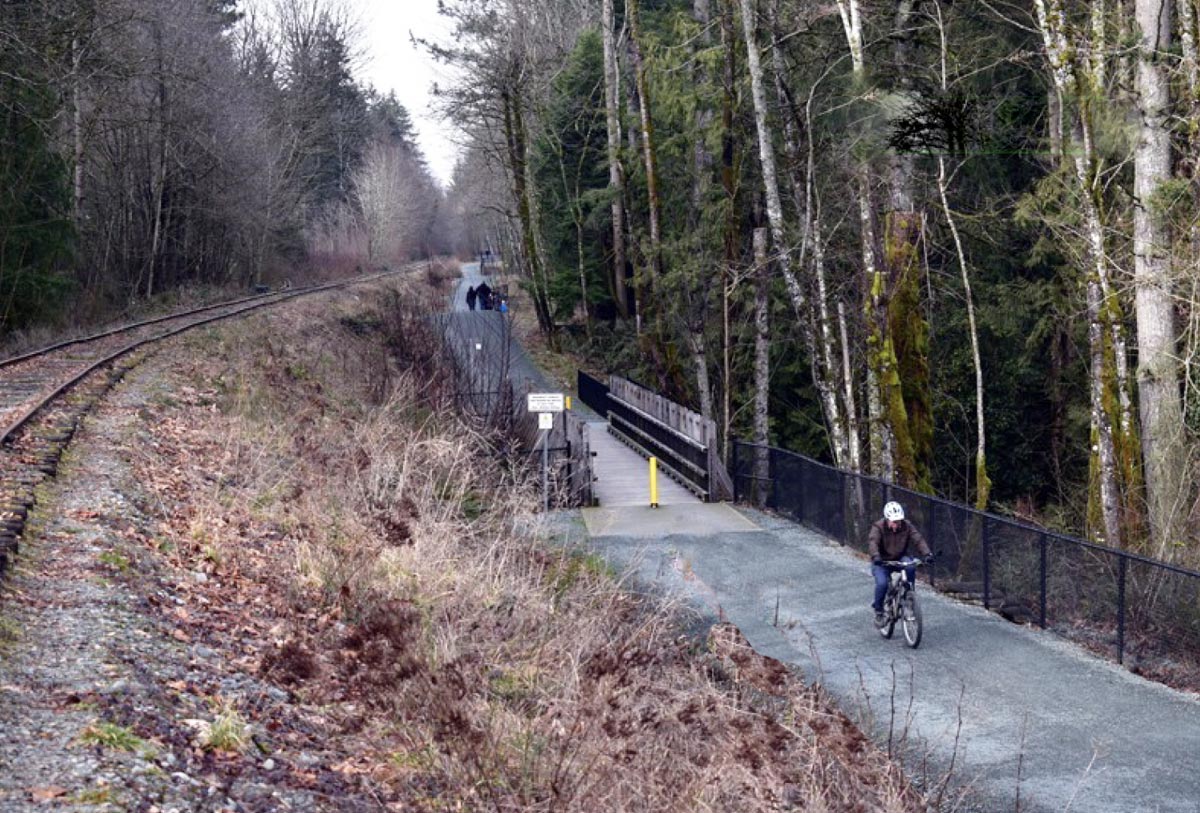Loon Lake, Mt Arrowsmith E&N (Photo: Kiwibirdman CC BY 3.0)
Study after study demonstrates the ecological, economic and health benefits of active transportation

A hub for active transportation
The trail will be an active transportation spine, with which local trails and bike paths would connect. Why not have rail with a trail?

A safer alternative
Recreational, tourist and commuter users will be able to walk or ride in a safe, quiet, accessible environment. With the boom in e-bikes, there is increased demand for longer, enjoyable rides, whether commuting or recreating.

Positive economic footprint
A 2023 report shows the trail will "become a popular outdoor recreation destination [that will] attract users from all provinces and from other countries." Rather than drain millions in public funds, the trail will add to them. Local small businesses will benefit. First Nations in other parts of Canada have benefited economically and culturally from the opportunities trails provide.
The many trestles and bridges on the Island Corridor could be like the Kinsol Trestle, very popular among locals and tourists. Specifically the Niagara Creek and Arbutus Creek trestles, among others, would become highlights and draws for tourists.

Preserves the corridor
Across North America, rail lines are being divided and sold, removing the possibility for them to provide uninterrupted transportation in the future. A continuous trail preserves the E&N Corridor for future generations at minimal expense. At the same time, we acknowledge that the entire Corridor passes through unceded First Nations territory and 2% of the track (6 km) passes directly through First Nations reserves. FORT-VI is dedicated to working with local First Nations to create economic opportunities along a future trail, or would support re-routing the trail around reserve land, if necessary.

Best for the environment
Once constructed, a multi-use trail has no added carbon emissions from motorised transport and creates a more natural environment for the enjoyment of all. The overall carbon burden of the trail is minimized by using natural materials like crushed stone for trail construction.

Positive health benefits
A 2023 feasibility study of the trail found that "well-planned, connected and accessible active transportation systems influence our health by increasing our physical activity, improving air quality and reducing vehicle injuries." Both physical and mental health will be boosted by a continuous Corridor trail.
Advantages for Residents
- Locals would use the trail for commuting and/or pleasure, while avoiding the hazards, congestion and noise of the road.
- Cyclists could safely travel to and between local communities for shopping, work or pleasure.
- Local businesses and First Nations could benefit from tourism traffic on the trail.
- Less noise and emissions pollution for people who live along the E&N corridor.
Advantages for Tourists
- The trail would be a drawing card for national and international tourists as the trail would link communities and tourist attractions up and down and across Vancouver Island.
- Studies estimate approximately $100m in annual economic benefit to Vancouver Island.
- Existing train stations could be made into information booths giving directions to local attractions and accommodations.
The opportunities associated with a continuous active transportation trail up and down and across Vancouver Island are tremendous. Construction will be simple and affordable. Residents, First Nation communities and local businesses could prosper from the trail. BC Transit’s Low Carbon Fleet Program will reduce the carbon footprint and improve public transit on Vancouver Island. Let’s not miss the opportunities and benefits to be had by turning the inactive Island Rail Corridor into a multi-use trail that connects Vancouver Island.
FAQ about the Trail

Rail with a trail could be the best of both worlds, if funds were unlimited. Indeed, regional districts have already paid to build 47 km of unconnected trails next to the E&N tracks.
North of Duncan most of these new sections of trails did not require expensive bridges or work in wetland habitats. To create a continuous trail while preserving the tracks for train traffic, these new trails must be built beside the varied terrain of the railbed at much higher cost:
- 40 bridges between Langford and Courtenay would need to be twinned or upgraded. These span a total of 2.1km of bridges.
- Another 19 bridges from Parksville to Port Alberni would also need major upgrading
- The 45m Malahat Tunnel would need to be enlarged or have a trail built skirting Tunnel Mountain.
Excluding the cost of rehabilitating the railbed, the cost of a trail alongside the rail is likely to be $2-3 million per km from Langford north.
The danger is that a trail would simply not get built while tracks remain on the railbed. It has taken $36 million for a trail to be built beside the rails between Vic West and Langford, a project started in 2006 and still not completed. Follow this link for more information about the complicated and expensive process on the CRD website.
Putting the trail on the railbed will be orders of magnitude cheaper than putting one beside the tracks. Furthermore, a trail does not preclude establishing rail service in the future should that become economically viable.
First Nations are crucially important on this issue and must be involved in decisions of how to manage the Island Corridor for the future.
Some First Nations groups have asked to have the Corridor lands returned to them. Others are interested in the idea of a trail as a linear park through their community.
FORT-VI is dedicated to the reconciliation process and supports working with First Nations members to provide trail developments that are respectful of their needs. This includes helping create economic opportunities for First Nations along a future trail or re-routing the trail around First Nations land where requested.
Trains may reduce traffic but they are not expected to meaningfully eliminate congestion on the Malahat highway.* We advocate that funds which could have been spent on the train be dedicated to a fleet of electric buses. The $431 million needed to rehabilitate the train line could buy more than 300 electric buses that would reduce traffic and provide climate-friendly public transportation across the Island - including The Malahat.
It is also possible that the new trail could be used for emergency use over the Malahat. If the bridges are strengthened and the trail is sufficiently wide, ambulances, police vehicles or blocked cars could potentially drive on the trail in time of need. A train line would not have this kind of flexibility.
* Trans-Canada Highway 1 - Malahat Corridor Study Appendix K, July 2007 (Halcrow Consulting)
Train transportation is a form of mass transit that can reduce greenhouse gases in or between urban areas which fill trains. However, most proposals for renewed rail service on the Corridor include diesel-powered trains that are low frequency. For passenger rail to be efficient, trains must be full and use the fixed assets (rebuilt railway) as much as possible. In short, the trains must draw passengers from more fuel intensive modes. Island rail corridor train proposals do not achieve this.
In every case where Rail to Trail has been completed, the end result is no added carbon emissions from motorised transport and a more natural environment for the enjoyment of all. The overall carbon burden of rail construction is also much greater than using natural materials like crushed stone for trail construction.
Economic impact studies document how local businesses along trails benefit from an influx of visitors. They also significantly improve municipal tax revenues.
Trails also support BC's Tourism strategy to sustainably grow the local and visitor economy while respecting the environment. The Island Rail Corridor passes through 21 different communities that are an average of 11 km apart. These distances are readily traveled by bike, especially e-bikes.
Numerous small businesses stand to benefit from a Corridor trail:
- Restaurants and Pubs
- Retail stores
- Campgrounds
- First Nations businesses
- Snack shops
- Lodgings (Hotels, B&B, Airbnb)
- Tour guiding and bicycle tours
A similar trail, the Great Allegheny Passage, generates around $121 Million in annual economic impact and has created more than 1300 jobs. Other rail-to-trail projects demonstrate similar results. For a majority of trails, the economic benefits generated by trails far outweigh the cost of trail construction and maintenance.

Trail construction involves removing rails and ties, grading, and then spreading surface material.
The work starts with sampling at intervals to determine whether hazardous material needs special disposal and treatment.
Pulling up existing rails occurs next. The salvage value of the rails is considerable, helping to offset the cost of their removal.
The multi-use trail then requires additions such as surface material, decking and railings at bridges and trestles, bollards at road crossings, fencing, signage, and picnic facilities. Cost estimates for this work depend on type of surface chosen, extent of amenities and level of volunteerism in each community.
Once the work is done, ongoing costs of maintaining the trail would include vegetation control, periodic remediation of surface, graffiti and garbage removal. Leases and other non-rail income would be used to help offset these expenses.
No. The steepest grades are less than 3%. Walkers and riders will barely know they are ascending or descending. Crossing the Malahat on the trail won't require the heroics of those who brave the Malahat (or the Trans Canada Trail which bypasses the Malahat) on foot or by bike today.
Electric assist bikes will be allowed on the non-motorised trail depending on bylaws. In provincial parks, class 2 e-bikes are no longer permitted. Class 2 e-bikes were recently permitted on the Okanagan Rail Trail. Find here the ICBC requirements for electric bicycles.
